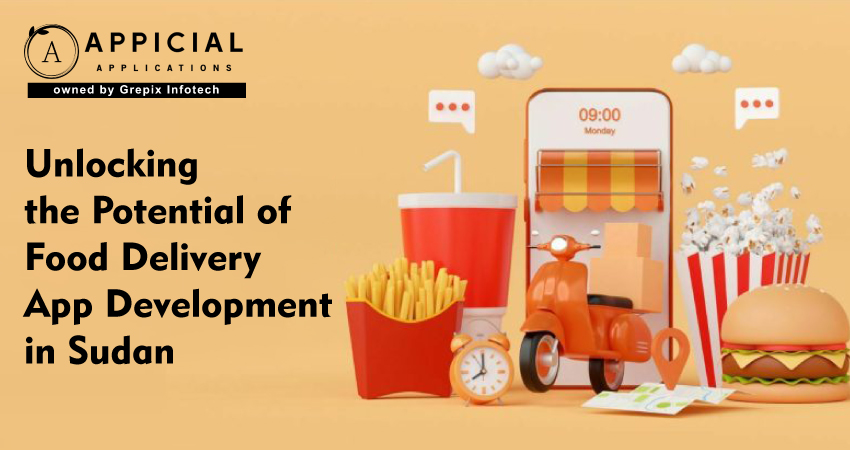
Unlocking the Potential of Food Delivery App Development in Sudan
Sudan is waking up to digital. More people now own smartphones. Cities like Khartoum, Omdurman, and Port Sudan are bustling. Yet most food still gets ordered by calls or in person. Delivery, if it exists, is inconsistent.
People want faster, traceable food ordering. They want app-based convenience, not guesswork. Restaurants want new revenue and better tracking. Customers want reliable delivery and secure payment.
That gap is your opportunity. A modern food ordering app can change the game. It offers real-time tracking, menu browsing, and seamless payments. It connects customers and restaurants through technology. It builds trust and repeat usage.
If you're planning a startup in 2025, now is the time. The market is young. Growing. And ready for app-based innovation. Let’s explore how to build a successful food delivery app development plan in Sudan.
Sudan’s online food delivery market is growing quickly. Revenue could reach approximately US$245 million in 2025, with steady growth expected through 2029. Internet users are slowly rising, with about 28.7% penetration in early 2025, equating to roughly 14.6 million users. Urban consumers increasingly expect convenience. Yet most restaurants manage orders manually or by phone. That gap creates opportunity. This blog walks you through why investing in a food delivery app in Sudan makes sense, what features users want, the technology you'll need, key challenges, costs, and how Appicial Applications can support every step of your journey.
Why Invest in Food Delivery App Development in Sudan?
- Rapid Market Growth
The food delivery sector in Sudan looks set to earn around US$245.4 million in revenue in 2025 and grow to about US$374.7 million by 2029. Grocery and meal deliveries are rising quickly across urban areas.
- Low but Rising Internet Adoption
As of January 2025, Sudan had about 14.6 million internet users, roughly 28.7% penetration. While 70% of the population is offline, growth continues as connectivity improves. The urban middle class and youth are increasingly digital.
- Young Urban Demographics
Sudan’s median age is 18.6 years. A large share of the population views smartphones as essential. They want convenience and variety in food choices.
- Under-served Food Delivery Space
Few local delivery apps currently offer robust service. Most restaurants rely on calls, SMS, or WhatsApp. That leads to missed orders and inconsistent experience; it’s a gap waiting for a modern food delivery app.
- Consumer Shift Toward Digital Convenience
Urban users look for choices. They appreciate simple menus, clear pricing, tracking, and payment flexibility. Preferences are shifting from traditional ordering to app-based services, today, tomorrow, and long-term actions.
- High Demand for Food Innovation
There’s growing interest in healthier, local, and specialty options. People lament the lack of variety in food options and service quality on Reddit and other forums. A well-executed food ordering app platform could deliver better options. It could introduce cuisines and convenience to urban dwellers.
- Integration with Digital Payments
While cash remains king, digital payments are emerging. Developing support for mobile wallets or card payments places your food delivery app development plan ahead, especially in cities where digital uptake is rising.
In short, the addressable market is young, tech-curious, and under-served. A well-built food delivery app can win customers and partner businesses early, then scale.
What are the Must-Have Features for a Food Delivery App?
Building a great food delivery app means balancing user expectations with local realities. Here’s what you need:
Customer App Features
- Easy sign-up via phone or email
- Menu browsing with categories and images
- Real-time tracking (think DoorDash delivery app style)
- Estimated delivery time and live updates
- Payment options: cash on delivery, local mobile wallets, or cards
- Push and SMS notifications
- Ratings and reviews
- Promo codes and loyalty rewards
Restaurant Partner App
- Accept or reject orders
- Order queue with cooking time estimates
- In-app chat and alerts for new orders
- Sales dashboard with order history and peak time reports
Courier/Delivery App
- Job alerts and vehicle assignments
- Navigation with optimized routing
- Status updates: pickup, in transit, delivered
- Earnings tracker and daily summary
Admin Dashboard
- Monitor delivery volume and completion rate
- Manage users, restaurants, and delivery agents
- View analytics: busiest zones, order times, cancellations
- Generate and manage promotional campaigns
- Handle customer support tickets
These features support a reliable, user-friendly service. They align with global platforms like Grubhub delivery or DoorDash food delivery, but are tailored to Sudan’s landscape.
Technology Stack and Architecture
Frontend (Mobile and Web)
Use cross-platform tools like Flutter or React Native for apps. Build admin dashboards using React.js or Angular. This ensures a clean and consistent user interface.
Backend
Node.js with Express, or Python’s Django, are reliable choices. Use PostgreSQL or MongoDB for the database. Redis can help with caching and real-time operations.
Integrations
- Google Maps API for tracking and navigation
- SMS or Firebase for notifications
- Simple payment gateway integration for local wallets or cards
Hosting and Deployment
Use AWS, DigitalOcean, or Azure. Digital infrastructure in Sudan varies; low-latency local edge hosting helps urban users. Consider offline caching for weaker networks.
Architecture
Build modular architecture: separate services for customer, restaurant, courier, and admin logic. This design makes it easier to iterate on features like real-time tracking, analytics, or dynamic pricing.
With this stack, you'll deliver a scalable, maintainable, and flexible food delivery app development platform.
What are the Challenges and Market Gaps in Sudan?
Sudan poses its own set of realities. However, that also creates space for innovation.
- Limited Internet Access
Just under 30% of the population is online. Urban areas lead in connectivity. Rural regions remain underserved. Your app must be lightweight. Use low-data modes. SMS backup might help with notifications.
- Connectivity Costs are High
Data bundles are costly relative to average income, 1GB costs around 980–1,000 SDG (~$1.5–USD 1.7). Optimize for minimal bandwidth usage and fast load speeds.
- Economic Instability and Food Insecurity
Sudan continues to face food shortages worsened by conflict. Supply chain disruptions impact the availability and pricing of ingredients and meals. Many customers may prioritize essentials, which can impact app adoption in certain regions.
- Trust Deficit
Customers worry about food safety, delayed delivery, or cancellations. Visible tracking, verified menu hygiene, and clear refund policies build real trust.
- Payment Limitations
Credit card usage is rare. Cash is common. Mobile payment is emerging but fragmented. Integrate widely accepted payment options.
- Restaurant Digital Readiness
Most local vendors rely on in-person or phone orders. Onboarding requires training, simple tools, and trust-building. Your rollout plan should include restaurant support sessions.
- Regulatory Barriers
Operating in Sudan can involve local licensing, import controls, or trade restrictions. Stay informed and plan for compliance.
If you build thoughtfully with these realities in mind, you gain a major edge.
Also Read: How to Start a Food Delivery App Business in Angola
Estimated Development Cost & Timeline
Phase 1: MVP Launch
- Customer app, restaurant app, delivery app, admin dashboard
- Basic tracking, ordering, payments, and messaging
- Timeline 3–4 months
- Estimated cost US$20,000–35,000 USD
Phase 2: Feature Expansion
- Loyalty rewards, advanced analytics, multi-language, in-app chat, dynamic routing
- Timeline additional 3–5 months
- Estimated cost additional US$30,000–60,000 USD, depending on features
Ongoing Costs
- Infrastructure: hosting, data usage, server costs
- Operations: onboarding, support, marketing
- Updates: troubleshooting, feature enhancements
Starting with a lean MVP enables you to test in cities like Khartoum. Then refine and expand based on user feedback. This staged approach reduces initial risk and aligns with growth pacing.
How Appicial Applications Can Help?
At Appicial Applications, we specialize in custom food delivery app development in Sudan for emerging markets. We understand Sudan’s context and constraints.
- Localized Platform Templates
We offer basic templates optimized for local payment systems and menus. They mimic global platforms like Grubhub delivery or DoorDash delivery app, while adapting to Sudan’s realities.
- Lightweight UI & Data Efficiency
Our apps load fast. They use minimal bandwidth. They run well on low-end Android devices common in Sudan.
- Payment Integration Support
We integrate with accepted local payment methods, cash, wallet, or card. Our team supports payments like BayQi or bank transfers, where available.
- Onboarding and Vendor Support
We guide restaurants and couriers step-by-step through the onboarding process. We provide documentation, training, and support to drive adoption.
- Post-Launch Services
We stay on with bug fixes, feature enhancements, customer support setup, and growth advice. We help optimize for repeat orders and customer retention.
- Transparent Pricing & Flexible Contracts
We tailor pricing to suit startups and growing businesses. You always know what you’re paying for and what you get in return.
Conclusion
Sudan’s food delivery ecosystem is still emerging. But signs point to opportunity. Smartphone use is rising. Urban consumers need convenience. Restaurants need digital solutions. Infrastructure is improving.
If you build a smart food ordering app, you solve real problems. You connect people with food they love. You empower local vendors. You capture a growing market before others catch on.
Keep the app simple, reliable, and lightweight. Add tracking, ratings, and secure payments. Launch lean. Test with early urban users. Iterate quickly.
With the right strategy and a partner like Appicial Applications, you can build something meaningful. You can lead Sudan’s digital food transformation. The potential is there. The demand is waiting. The time is now.
FAQs
Author's Bio

Vinay Jain is the Founder at Grepix Infotech and brings over 12 years of entrepreneurial experience. His focus revolves around software & business development and customer satisfaction.
Back to blog list




